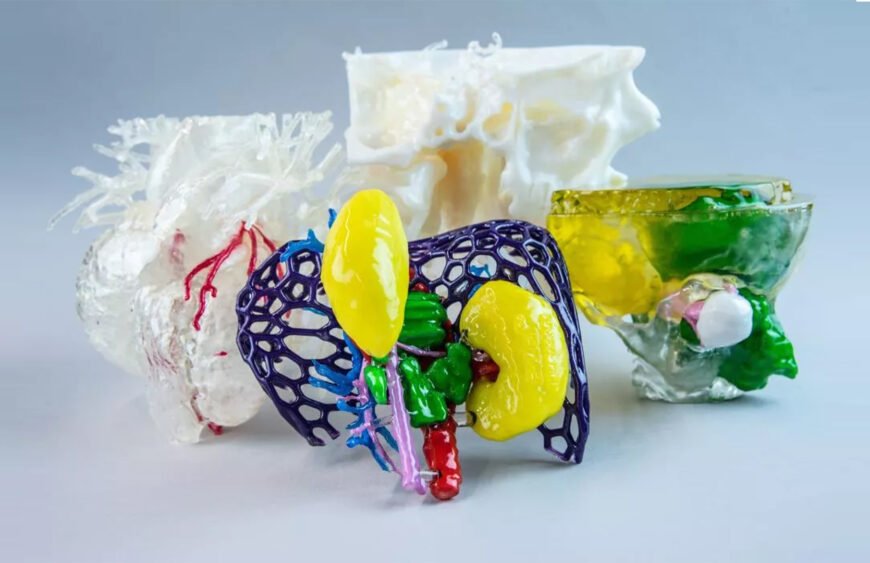PolyJet 3D printing is an advanced additive manufacturing technology known for its high precision and versatility. It works by jetting layers of photopolymer materials onto a build platform, which are then cured with UV light. This process allows for the creation of detailed, multi-material, and multi-color prototypes in a single print. Unlike traditional 3D printing methods, PolyJet can produce smooth surfaces and complex geometries, making it ideal for industries like product design, healthcare, and automotive. As it gains popularity in India, PolyJet is revolutionizing how designers turn their concepts into tangible, high-quality products.
The Process of PolyJet 3D Printing
PolyJet 3D printing operates by precisely depositing tiny droplets of liquid photopolymer onto a build platform, layer by layer. These droplets are instantly cured using UV light, solidifying them into the desired shape. The process involves multiple print heads, allowing for the simultaneous use of different materials and colors. Support materials are also printed to handle complex geometries, which can be easily removed after printing. The combination of high resolution and multi-material capabilities enables designers to create intricate models with smooth finishes and detailed features, ideal for prototyping and manufacturing in various industries across India.
Applications of PolyJet 3D Printing in Design

PolyJet 3D printing is revolutionizing product design by enabling rapid prototyping with unmatched precision. In industries like consumer electronics and automotive, designers can quickly iterate and refine their products, reducing time-to-market. The technology’s ability to print complex, multi-material models makes it ideal for creating realistic prototypes that closely mimic final products.
In the medical and dental fields, PolyJet is used for custom implants, surgical guides, and dental prosthetics, offering high accuracy and biocompatibility. In India, PolyJet’s impact on manufacturing is significant, driving innovation and efficiency across diverse sectors, from healthcare to industrial design.
Benefits of PolyJet 3D Printing
PolyJet 3D printing offers numerous advantages that make it a preferred choice for designers and manufacturers. Its ability to produce high-resolution, multi-material, and multi-color models in a single print run significantly enhances design flexibility. This precision allows for the creation of detailed prototypes and end-use parts with smooth surfaces and intricate geometries, reducing the need for post-processing.
Compared to traditional manufacturing, PolyJet is faster and more cost-effective for small to medium production runs, enabling quicker turnaround times. For Indian designers, the technology’s adaptability and efficiency translate into reduced development costs and accelerated innovation across various industries.
Challenges and Considerations
While PolyJet 3D printing offers numerous benefits, some challenges must be considered before adoption. The initial investment in PolyJet printers and materials can be high, making it crucial to assess return on investment, particularly for small businesses. Additionally, the technology requires skilled operators to manage the complex printing process and optimize design files for the best results.
Material compatibility and availability in India may also pose challenges, especially for specialized applications. However, these challenges can be mitigated through proper training, selecting the right partners, and leveraging design for manufacturability (DFM) principles to maximize the potential of PolyJet printing.

The Future of PolyJet 3D Printing in India
The future of PolyJet 3D printing in India looks promising as the technology gains traction across various industries. With the Indian government’s push towards innovation and digital manufacturing, PolyJet is set to significantly advance the country’s design and manufacturing capabilities. Emerging trends, such as the development of new materials and improvements in printing speed, will further enhance PolyJet’s appeal.
As Indian companies increasingly adopt this technology, we can expect to see a surge in high-quality, locally manufactured products. The potential for PolyJet to transform sectors like healthcare, automotive, and consumer goods in India is immense, driving innovation and economic growth.
Conclusion
PolyJet 3D printing is transforming design and manufacturing in India by offering unmatched precision, versatility, and efficiency. From rapid prototyping to producing end-use parts, its ability to handle complex, multi-material designs makes it a powerful tool for innovation across industries. As the technology continues to evolve and gain acceptance, Indian designers and manufacturers are well-positioned to leverage PolyJet for faster, cost-effective product development, driving the country’s growth in the global market. Now is the time to explore its possibilities.






